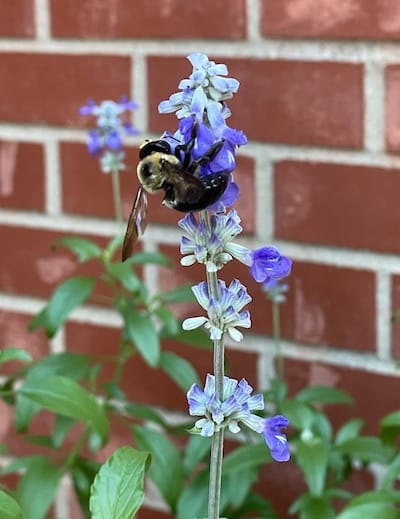Spring is beautiful in Kentucky. Dogwood, redbuds and tulip trees abound and tulips, daffodils, iris and azaleas brighten our surroundings. Garden centers bustle with energized customers looking for the perfect outdoor flowers. Farmers’ markets open with the abundance of strawberries, tomatoes and cucumbers. All are delights to the human eye, but little thought is given to the common thread among them — the honeybee! With the recent celebration of World Bee Day, it’s only fitting to recognize the big role these tiny pollinators play with food on our table; a role in which we all can participate! Bee-friendly food is a feast for all.
Value Beyond Honey

Apples, melons and broccoli to blueberries, cherries and almonds depend on the honeybee. For example, blueberries and cherries are 90% dependent on honeybee pollination while almonds are entirely dependent on the honeybee for pollination at bloom time. With this type of dependency, beekeeping extends beyond the occasional hive or two an individual may keep for backyard honey.
“Behind the Scenes” Farmers
American beekeepers are “behind the scenes” farmers. It is estimated there are almost three million bee colonies in the U.S. with two-thirds of them traveling the country annually, providing the essential crop pollination for foods we take for granted. California almonds are the perfect example. Approximately 1.8 million colonies of honeybees are needed each year to pollinate the one million acres of producing almond orchards!
But all is not sweet for bees and beekeepers! The impact of pesticides, pests and diseases, along with decline of available forage and drought, is contributing to higher-than-average colony collapse and hive losses.
Bee Friendly Tips
While most of us will never manage beehives or transport bee colonies, we can make our yards, flowerpots and gardens bee health friendly. While the absence or appearance of bees in our yards or around our flowerpots is probably a good indicator, here are some guidelines:
- Think bright white, yellow, blue or UV petal flowers! Those that are full of nectar with a sweet aromatic or minty fragrance and a landing platform are considered the prime choice for bees. Even though I love red geraniums in our backyard, they are not conducive to bees. Bees don’t see red!
- Like all of us, bees need water. Bird baths work great if they’re shallow and lined with rocks or sticks on which bees can land. Our backyard fishpond’s fountain is a bee’s delight!
- And finally, don’t stress over a few weeds in the yard. We may not subscribe to the #NoMowMay movement, but an occasional dandelion, wild violet or clover in our yards is a bee’s delight. Dandelions are often the first source of food for bees after the winter months.
Whether we enjoy the direct “fruit of the bee’s labor” or not, we all have a vested interest in the honeybee. Keeping a “bee friendly” planet is a truly a food feast for all.
Resources:
- World Bee Day: May 20, Food and Agriculture Organization of the United Nations
- Pollination Facts: Honey Bees Are Pollinators, American Beekeeping Federation
- Honey Bees & Pollination, National Honey Board
